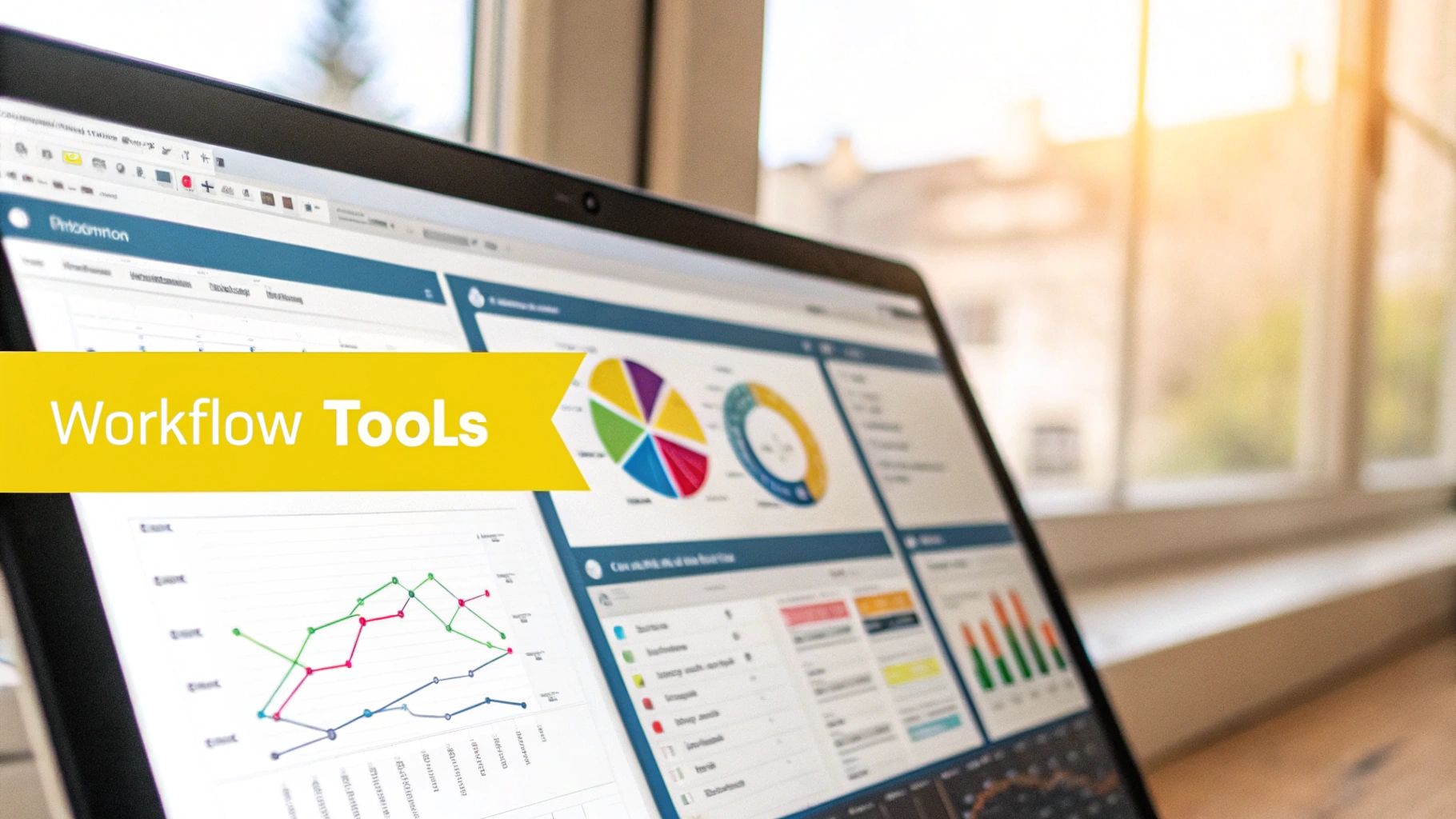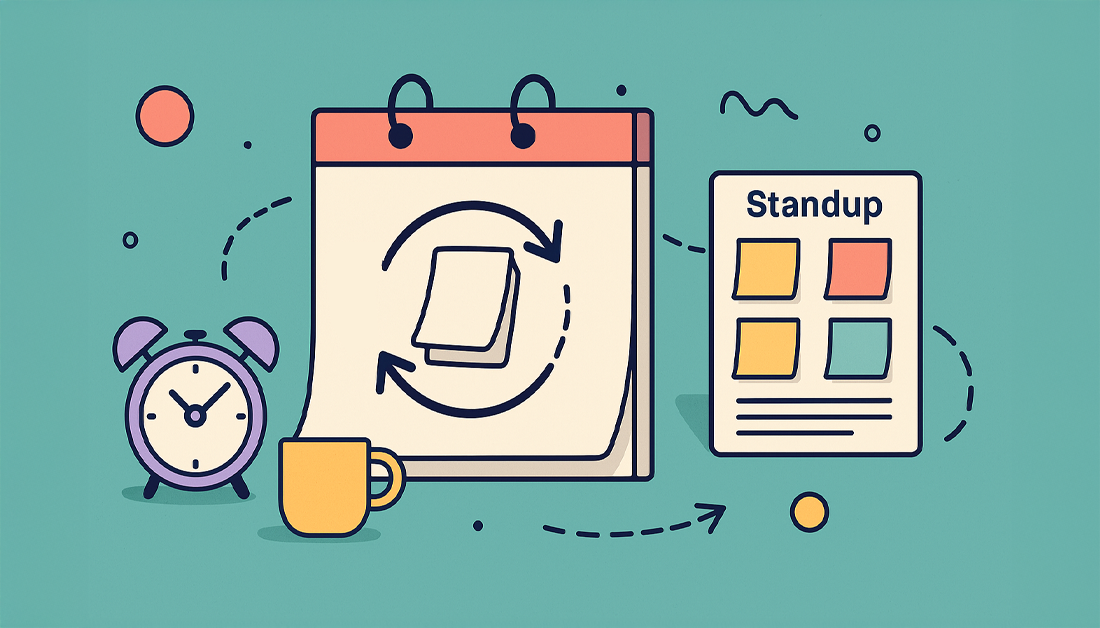Why Your Current Standup Feels Like Groundhog Day
Ever feel like your daily standup is stuck in a rut? Like you’re just going through the motions, rehashing the same updates day after day? Trust me, you’re not the only one. I’ve talked to countless team leads who feel the same way. There’s often a disconnect between what a standup should be and what it actually is. Sometimes, it’s not the daily standup meeting template itself, but the habits we fall into. Even if you’re using other helpful templates, like a software documentation template, your standups can still become stale.
One of the biggest culprits? Focusing only on what got done, not why it matters. Just listing tasks doesn’t give anyone context or build a shared understanding of the team’s goals.
Another common issue is a lack of real interaction. When people just report their status without actually connecting, the meeting becomes robotic and loses its energy. It’s important to remember that standups are a key part of Agile methodologies, designed for quick updates and identifying roadblocks. Their effectiveness can be debated – some even argue they can stifle innovation. You can learn more about daily stand-up meetings here and find some great tips on running them effectively here.
So, how do you break the cycle and make your standups more engaging and dynamic? The key is to shift your perspective. These meetings aren’t just about managing tasks. They’re about building connections, collaborating effectively, and making sure everyone is on the same page. That change in mindset can unlock the true potential of your daily standup.
Crafting Your Team’s Perfect Meeting Rhythm
Forget generic daily standup meeting templates. The best ones fit your team’s workflow and personality. A good template sets the stage for a productive and engaging meeting, from start to finish. This infographic visualizes the key parts of a daily standup meeting template, highlighting the elements that contribute to a focused and efficient discussion.

As the infographic shows, a successful standup meeting relies on a well-defined structure, clear communication, and action-oriented outcomes. It’s not just about what got done; it’s about understanding why it matters and how it contributes to the big picture.
Adapting the Core Questions
The classic “what did you do yesterday, what are you doing today, and what’s blocking you?” questions are a solid starting point. But you can adapt them for your team. Instead of just reciting updates, encourage your team to connect their work to project goals.
For example, instead of “I finished coding module X,” a team member could say “I finished coding module X, which means we’re now ready to start testing feature Y.” This adds context and helps everyone understand the impact of each person’s work. For more ideas, check out this guide on scrum daily standup meeting templates.
Embracing Alternative Formats
Sometimes, you need to refresh the traditional standup. Experiment to keep things interesting. Consider a “walk the board” standup, visually tracking progress on a Kanban board. This helps everyone visualize the workflow and spot bottlenecks. Or try a “round robin” format, where each person answers a single, focused question related to a key project milestone. These changes can energize your daily routine.
Let’s take a look at how these different formats stack up against the traditional approach. The table below summarizes the key differences.
To help you choose the right format for your team, I’ve put together a comparison table:
Standup Template Comparison: Traditional vs. Enhanced Formats
A comparison of traditional standup formats versus modern enhanced approaches, showing structure, time allocation, and engagement levels
| Format Type | Structure | Duration | Engagement Level | Best For |
|---|---|---|---|---|
| Traditional | 3 Questions (Yesterday, Today, Blockers) | 15 minutes | Can become routine | Established teams, simple projects |
| Walk the Board | Visual progress tracking on Kanban board | Variable, depends on complexity | High, visual and interactive | Teams using Kanban, complex projects |
| Round Robin | Single focused question per person | Short, usually under 15 minutes | Focused, promotes deep dives on specific topics | Teams needing alignment on key issues |
As you can see, each format has its own strengths. The key is to choose the one that best suits your team’s needs and project complexity. Don’t be afraid to experiment! You might find that a hybrid approach works best.
Making Remote Standups Actually Work

Let’s be honest, remote standups can sometimes feel like a black hole of productivity. I’ve seen it firsthand – glazed-over eyes staring at muted screens while everyone pretends to listen. But I’ve also worked with distributed teams who’ve cracked the code and made their remote standups not just tolerable, but genuinely valuable.
The secret? Intentional connection. Forget trying to recreate the in-person magic. Remote work demands a different approach, one that embraces the unique advantages and challenges of the virtual world. This means being mindful of time zones and actively working to bridge the distance between team members.
One simple trick is establishing communication rituals. Think a quick icebreaker or a shared “virtual coffee” before diving into the updates. This can help create a more relaxed and engaging atmosphere, especially for teams spread across the globe. For more tips on improving remote collaboration, check out this resource: improve remote collaboration. A solid daily standup meeting template is also essential. Think of it as your backup plan for when (not if) the tech decides to act up.
Speaking of tech, using a tool like NASA – Not Another Standup App can be a total game-changer. Preset agendas and turn-based sharing features keep things structured and ensure everyone gets a chance to speak. No more meeting hijacking by the loudest voice! Plus, gathering async updates beforehand frees up the live meeting for actual problem-solving and collaboration.
This creates a real sense of shared purpose, even with a distributed team. Looking for other ways to boost team engagement? Here are some ideas: virtual team engagement activities. By combining these strategies, your remote standups can become a powerful tool for maintaining team culture and forward momentum, regardless of where your team members are located.
Navigating the Awkward Moments Like a Pro
Every facilitator’s been there. That teammate whose “quick update” morphs into a TED Talk. The quiet genius who’s brimming with ideas offline but clams up in standup. Or, the simple question that somehow sparks a full-blown debate. These are the moments that can derail a standup faster than you can say “action item.”
So, how do you handle these tricky situations gracefully and keep your standup on track? Diplomacy is the name of the game. Think redirection, not a hard stop. If someone’s over-sharing, gently interrupt with phrases like, “Great detail! Can we dive into that offline?” or “Let’s make sure we hear from everyone; can we circle back later?” This acknowledges their input while keeping the meeting moving.
For the quieter folks on the team, create a space where they feel comfortable contributing. Direct questions are your friend: “Sarah, I’d love your perspective on this,” or “John, what are your thoughts on next steps?” Sometimes, a quick check-in before the standup works wonders. A simple, “Anything you want to bring up in standup today?” can help them gather their thoughts.
And then there are the conflicts. They’re inevitable. When disagreements pop up, acknowledge the tension and suggest taking it offline. “It sounds like we have different viewpoints here. Let’s schedule a quick chat after standup to discuss this further.” This prevents the standup from turning into a battlefield and allows for a more focused discussion later. Check out this guide on standups using NASA if you’re interested in diving deeper. Remember, reading the room and adapting your approach is crucial for any facilitator. It’s all about balancing structure with flexibility and creating a respectful environment where everyone feels comfortable sharing.
Tracking What Actually Matters

It’s easy to get bogged down in the details of daily standups. Are we under 15 minutes? Did everyone get a chance to speak? Those things are important, sure, but they’re just scratching the surface. The real measure of a good standup is its impact: is it actually helping your team hit its goals? That’s the question that keeps me up at night (well, not really, but you get the idea).
This ties into the bigger picture of meetings in general. Managers already spend over 50% of their time in meetings, and that number is projected to jump to nearly 34% more by 2027. Daily standups, if done right, can be an antidote to pointless meetings, which reportedly cost businesses roughly $34 billion a year. For more on that, check out these meeting statistics. But even standups can become a drain if you’re not careful.
So, what should you be measuring? Effective teams go beyond simple attendance and timekeeping. They focus on action item completion rates, how quickly blockers are resolved, and – this is a big one – the overall team sentiment. Think of these as the vital signs of a healthy standup. If the mood is consistently low or blockers are piling up, it’s a clear sign that your daily rhythm needs a refresh.
Measuring What Matters: A Practical Approach
Getting feedback is essential. Simple tools like quick polls in NASA – Not Another Standup App can tell you a lot. Even a quick “thumbs up/thumbs down” can be surprisingly revealing. And don’t be afraid to ask direct questions like, “Is this meeting helpful?” or “What could we improve?” Honest feedback, combined with the right metrics, paints a clear picture of your standup’s true value. You might also find this guide on Meeting Notes and Action Items helpful.
To help you track your standups effectively, I’ve put together a handy table:
Standup Effectiveness Metrics: What to Track and Why
Key performance indicators for measuring standup meeting success, including frequency, engagement metrics, and outcome measurements
| Metric | How to Measure | Target Range | Warning Signs |
|---|---|---|---|
| Action Item Completion Rate | Track completed action items vs. assigned action items. | 80-100% | Consistently below 70% indicates issues with follow-through. |
| Blocker Resolution Time | Measure the time it takes to resolve reported blockers. | Less than 24 hours for most blockers. | Blockers persisting for days or weeks suggest systemic problems. |
| Team Sentiment | Use quick polls, surveys, or “thumbs up/thumbs down” check-ins. | Generally positive or neutral. | Consistently negative sentiment indicates underlying team issues. |
| Meeting Duration | Use a timer or meeting software with tracking features. | 15 minutes or less. | Regularly exceeding 15 minutes suggests inefficiency. |
| Participation Rate | Observe who contributes and how often. | All team members contribute regularly. | Some team members consistently silent or dominating the conversation. |
This table summarizes the key metrics you should focus on. By consistently tracking these areas, you can identify potential problems early and make your standups more effective. Remember, the goal isn’t just to have a meeting, it’s to make that meeting a valuable use of everyone’s time.
Keeping Your Standup Fresh Over Time
The best daily standup meeting templates aren’t set in stone. They evolve as your team and projects do. Think of it like a garden – you wouldn’t just plant seeds and walk away. You’ve got to nurture it, weed it, and adapt as the seasons change. Your standup needs that same kind of attention.
Regularly checking in on what’s working (and what’s not) is crucial. Noticed a drop in engagement lately? Are action items constantly being pushed back? Those are telltale signs your standup needs a refresh. Don’t be afraid to experiment! Maybe ditch the standard three questions and try a visual approach like walking the board. Or perhaps a focused discussion on a single, key challenge would be more impactful.
Introducing Change Without Disruption
Change is good, but sudden change can be disruptive. Instead of springing a new format on your team out of the blue, communicate the why. Explain the benefits and get their input. This collaborative approach builds buy-in and makes the transition much smoother.
Maintaining Momentum During Long Projects
Long projects can make standups feel stale. It’s easy to lose that initial spark. One way to combat this is by injecting some fun. Think themed standups, quick icebreakers, or a rotating “facilitator of the day.” These small changes can make a big difference in keeping energy levels up. I’ve seen teams introduce quick creative challenges or even mini-celebrations for small wins. It’s about reminding everyone they’re a team, especially when the workload gets heavy.
Your Implementation Game Plan
Ready to give your daily standups a boost? This isn’t about a complete redesign, think more of a tune-up. This week, let’s focus on three key things:
- Take Stock of Where You Are: Honestly, how are your current daily standups really going? What’s working well? What’s falling flat? A quick anonymous poll within NASA – Not Another Standup App can give you some great feedback. Are blockers actually getting resolved? Is everyone participating, or just going through the motions? This information will show you exactly where to focus your energy.
- Pick Your Battles: You don’t need to change everything at once. Based on your assessment, pick one or two areas to improve. Maybe you want to add something visual, like integrating a Kanban board. Or maybe you just need to tighten up the timing. Small, targeted changes are much more effective than huge overhauls.
- Get Everyone On Board: Change can be a little bumpy. Talk to your team about why you’re making these changes. Explain the benefits and get their input. This not only makes the transition smoother, it also helps your team take ownership of the process. And be sure to celebrate those early successes – it builds momentum!
This kind of step-by-step approach is what creates lasting change. Regular tweaks, based on real data and feedback, are the key to a truly successful daily standup.
